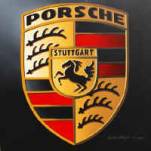



|
|
|
| By Jim Mateja Chicago Tribune March 23, 1987 What a difference automatic makes. The 1987 Porsche 928S 4 is powered by a 5-liter, 32-valve 8-cylinder engine that develops 316 horsepower. Porsche boasts that it will propel you from zero to 60 miles an hour in 5.7 seconds with 5-speed manual transmission. But we found when driving the car with the 5-speed (Autos/Monday, Nov. 24) that rather than streak to 60, you stutter, with the finicky manual transmission that`s neither smooth nor cooperative. With automatic, a no-cost option, you have to settle for zero-to-60 in 6.3 seconds rather than 5.7 and have to be content with a top speed of 162 miles an hour rather than the manual`s 165 m.p.h. Life can be cruel. But for the 0.6 second and 3 m.p.h. you lose, you gain far more driving pleasure from the ability to get in and go, to enjoy without worry whether it will be second or third gear that stiffens up on you. And 5 forward gears do little for the performance image when nestled bumper to bumper in rush hour traffic. There`s another factor to consider in the choice of 5-speed or automatic: Resale and the ability to get rid of the toy when you`re done playing with it. Porsche says 80 percent of its 928S 4 buyers opt for automatic. With 4 out of 5 buyers favoring automatic on a new 928S 4, that means you`ll have a larger potential market of buyers for the car when it`s time to dispose of it. A decade ago, automatic meant sluggishness and a loss of fuel economy. It was meant for a family sedan. With technological and engineering advances, there`s no comparison of today`s automatics with those of the past. As one example, with automatic the city mileage rating of the 928S is 16 miles per gallon versus 15 m.p.g. with manual. As another example, in the test drive we peeked into the rear-view mirror and spotted a Trans Am approaching at a fairly good clip because the front end was getting larger. As the driver started to swing intothe passing lane, we stepped on the accelerator. The response was immediate without any automatic lag time. The Trans Am faded into the background. The 928S 4 comes with a four-wheel antilock brake system (ABS) as standard to prevent wheel lockup in a panic stop. It`s much appreciated and you can expect ABS to be offered in more performance cars. After all, it`s nice to get from zero to 60 in 6.3 seconds, but far more important to get from 60 to zero in a straight line when you have to. When the pavement is dry, the wider 16-inch tires in back sit still and hug the road. Except for overly stiff power steering, handling is responsive, considering the car`s weight. A drawback with the 928S 4 and a feature ABS isn`t meant to cure is that the rear end gets antsy when the roads are snowy or wet. The car`s 300 horses and 3,600 pounds of weight are best left in the garage under those conditions. The 928S 4 (for four valves per cylinder) features an aerodynamic nose incorporating fog and driving lights and a new integrated spoiler for `87. In back, there are wraparound stoplights and a new detached rear spoiler to reduce lift. There`s a ``belly pan`` below the engine compartment to improve air flow beneath the car. Despite styling changes, the car is clearly a Porsche and attracts far more attention than ordinary missiles such as Supra, RX-7 and Corvette. One annoying aspect of the car`s styling is the round headlights that pop up when in use. Covers would look better, as would rectangular lamps. Another annoyance was an inability to get a proper seat adjustment without lots of fiddling with the controls. The model we drove wasn`t equipped with the memory seat Porsche calls ``Positrol.`` Memory wasn`t the problem; finding a few inches more for the head under the roof was the hang-up. The 928S is a 2-plus-2, but the back seats are reserved for very little kids. Since it set p its own distribution network and broke ties with Volkswagen`s Audi division in 1984, Porsche sales have risen steadily. In 1984, sales were 19,611, climbing to 25,306 in 1985 and a record 30,471 in 1986. The forecast for 1987 is to equal or top the record. In Chicagoland, sales rose by 45 percent in 1986 to 1,098 cars from 761 the previous year. Porsche is trying a new strategy with the 928S 4; it`s cutting the number shipped here to 2,200 for 1987 from 2,800. The feeling is that demand always should exceed supply, that one too few is favorable to one too many, which is what helps make a flagship rather than a dinghy. More 924S and 944S models will be shipped here instead. Another feature that makes a car a flagship is price and the 928S 4 since Jan. 1 carries a hefty $61,970 sticker, an increase from the $58,900 it started at last fall. Effective with all cars built in or after May (probably for arrival in June and later), the sticker goes up again to $63,520. The 924S entry-level Porsche rose to $22,995 Jan. 1 from $21,900 and moves to $23,910 after May. |
|
|
| |
|
|
| |
|
|
||
|
|
||
|
|
||